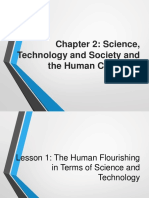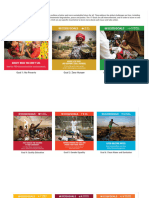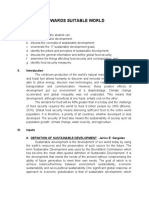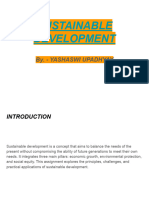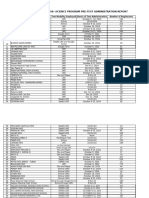Economics
Economics
Uploaded by
George Paul KuttikatCopyright:
Available Formats
Economics
Economics
Uploaded by
George Paul KuttikatCopyright
Available Formats
Share this document
Did you find this document useful?
Is this content inappropriate?
Copyright:
Available Formats
Economics
Economics
Uploaded by
George Paul KuttikatCopyright:
Available Formats
The 17 Goals:-
1. No Poverty
Goal 1 of the United Nations' Sustainable Development Goals (SDGs) is to "End
poverty in all its forms everywhere." This goal reflects a commitment to eradicate
poverty and improve the well-being of people worldwide. By 2030, it aims to
eradicate extreme poverty for all people everywhere which is currently measured as
people living on less than $1.90 a day and to reduce at least by half the proportion of
men, women, and children of all ages living in poverty. It will also ensure significant
mobilization of resources from a variety of sources, including through enhanced
development cooperation, to provide adequate and predictable means for developing
countries, in particular least developed countries, to implement programs and policies to
end poverty in all its dimensions. Eradicating poverty is a complex challenge that
involves addressing various interconnected issues, including income inequality, access to
education, healthcare, clean water, and economic opportunities.
2. End Hunger
It is to achieve food security and improved nutrition, and promote sustainable
agriculture." This goal is aimed at addressing one of the most fundamental challenges
facing humanity ensuring that everyone has access to enough nutritious food to lead
healthy and active lives. It ensures access by all people, in particular, the poor and people
in vulnerable situations, including infants, to safe, nutritious, and sufficient food all year
round. Guarantees sustainable food production systems and implement resilient
agricultural practices that increase productivity and production, that help maintain
ecosystems, that strengthen capacity for adaptation to climate change, extreme weather,
drought, flooding, and other disasters, and that progressively improve land and soil
quality. Achieving zero hunger involves not only increasing food production but also
improving the distribution of food, reducing food waste, promoting sustainable
agriculture, and addressing issues of poverty and inequality. It is an essential step toward
building a more equitable and sustainable world. To attain this goal, efforts from
governments, international organizations, farmers, businesses, and individuals are
necessary to ensure that nutritious food is available and accessible to all.
3. Good Health and Well-being
It is to "Ensure healthy lives and promote well-being for all at all ages." This goal focuses
on improving global health, reducing mortality rates, and promoting overall well-being
of the people. It aims to end preventable deaths of newborns and children under 5 years
of age, with all countries aiming to reduce neonatal mortality to at least as low as 12 per
1,000 live births and under-5 mortality to at least as low as 25 per 1,000 live births,
reduce the global maternal mortality ratio to less than 70 per 100,000 live births,
strengthen the prevention and treatment of substance abuse, including narcotic drug
abuse and harmful use of alcohol, halve the number of global deaths and injuries from
road traffic accidents, etc. It emphasizes the importance of accessible healthcare, disease
prevention, and promotion of mental health to ensure that people of all ages can lead
healthy and fulfilling lives. It acknowledges that health is not only the absence of disease
but also encompasses physical, mental, and social well-being. Achieving this goal
requires concerted efforts from governments, healthcare providers, civil society, and
individuals to improve healthcare systems, promote healthy behaviors, and address the
underlying determinants of health, such as poverty and environmental factors.
4. Quality Education
To "Ensure inclusive and equitable quality education and promote lifelong learning
opportunities for all." This goal underscores the importance of education as a
fundamental human right and a key driver of individual and societal development. It is
critical for personal development, economic growth, and social progress. Goal 4 seeks to
ensure that everyone, regardless of their background, has access to quality education
and opportunities for lifelong learning. It also emphasizes the importance of education in
fostering sustainable development, promoting gender equality, and building peaceful
and inclusive societies. Achieving this goal requires investments in educational
infrastructure, teacher training, curriculum development, and the removal of barriers that
limit access to education, especially for marginalized and vulnerable populations. It aims
to ensure by 2030 that all learners acquire the knowledge and skills needed to promote
sustainable development, including, among others, through education for sustainable
development and sustainable lifestyles, human rights, gender equality, promotion of a
culture of peace and non-violence, global citizenship, and appreciation of cultural
diversity and of culture's contribution to sustainable development.
5. Gender Equality:
This goal highlights the need to address gender-based discrimination, promote women's
rights, and create a more equitable and inclusive world for everyone. It aims to end all
forms of discrimination against all women and girls everywhere, including discrimination
based on gender, race, ethnicity, religion, disability, or other factors, eliminate all forms
of violence against all women and girls in the public and private spheres, ensure
women's full and effective participation and equal opportunities for leadership at all
levels of decision-making in political, economic, and public life, etc. Achieving gender
equality is not only a fundamental human right but also a necessary foundation for a
peaceful and prosperous world. Empowering women and achieving gender equality is not
only a matter of justice but also crucial for achieving all the other Sustainable Development
Goals.
6. Clean Water and Sanitation
To "Ensure availability and sustainable management of water and sanitation for all." This
goal emphasizes the importance of clean and accessible water resources and sanitation
facilities as fundamental elements for human well-being and sustainable development. It
aims to achieve universal and equitable access to safe and affordable drinking water for
all, access to adequate and equitable sanitation and hygiene for all and end open
defecation, paying special attention to the needs of women and girls and those in
vulnerable situations , improve water quality by reducing pollution, eliminating dumping,
and minimizing the release of hazardous chemicals and materials, halving the proportion
of untreated wastewater, and substantially increasing recycling and safe reuse globally,
substantially increase water-use efficiency across all sectors and ensure sustainable
withdrawals and supply of freshwater to address water scarcity and substantially reduce
the number of people suffering from water scarcity, etc.
7. Affordable and Clean Energy
To "Ensure access to affordable, reliable, sustainable, and modern energy for all." This
goal highlights the importance of energy access and its role in achieving various aspects
of sustainable development. It aims to increase substantially the share of renewable
energy in the global energy mix, double the global rate of improvement in energy
efficiency, ensure universal access to affordable, reliable, and modern energy services,
etc. Efforts to achieve this goal include expanding access to electricity and clean cooking
solutions, promoting the use of renewable energy sources such as solar, wind, and
hydroelectric power, improving energy efficiency in various sectors, and investing in
clean energy technologies. These actions not only contribute to energy access but also
help mitigate climate change and reduce air pollution, thereby benefiting both people
and the planet.
8. Decent Work and Economic Growth
It is to "Promote sustained, inclusive, and sustainable economic growth, full and
productive employment, and decent work for all." This goal emphasizes the importance
of economic development that benefits everyone, provides opportunities for decent
work, and supports sustainable livelihoods. It aims to sustain per capita economic growth
in accordance with national circumstances and, in particular, at least 7% gross domestic
product (GDP) growth per annum in the least developed countries, achieve higher levels
of economic productivity through diversification, technological upgrading, and
innovation, including through a focus on high-value-added and labor-intensive sectors,
Promote development-oriented policies that support productive activities, decent job
creation, entrepreneurship, creativity, and innovation, and encourage the formalization
and growth of micro-, small-, and medium-sized enterprises, including through access to
financial services, etc. Goal 8 recognizes that economic growth and employment
opportunities are essential for poverty reduction and social development. However, it
also emphasizes the importance of promoting sustainable practices, protecting labor
rights, eradicating forced labor and child labor, and ensuring equal access to economic
opportunities for all, regardless of gender, age, or disability.
9. Industry, Innovation, and Infrastructure
To Build resilient infrastructure, promote inclusive and sustainable industrialization, and
foster innovation. This goal emphasizes the crucial role of infrastructure development,
industrialization, and innovation in fostering economic growth, job creation, and
sustainable development. It aims to develop quality, reliable, sustainable, and resilient
infrastructure, including regional and trans-border infrastructure, to support economic
development and human well-being, with a focus on affordable and equitable access for
all, increase the access of small-scale industrial and other enterprises, in particular in
developing countries, to financial services, including affordable credit, and their
integration into value chains and markets, Promote inclusive and sustainable
industrialization and, by 2030, significantly raise industry's share of employment and
gross domestic product (GDP), in line with national circumstances, and double its share
in least developed countries, enhance scientific research, upgrade the technological
capabilities of industrial sectors in all countries, in particular developing countries,
including, by 2030, encouraging innovation and substantially increasing the number of
research and development workers, support domestic technology development,
research, and innovation in developing countries, including by ensuring a conducive
policy environment for, inter alia, industrial diversification and value addition to
commodities, etc.
10. Reduced Inequality
Goal 10 is to "Reduce inequality within and among countries." This goal highlights the
importance of addressing inequality in all its dimensions, including income, gender, age,
disability, and more, to promote a more just and equitable world. It aims to sustain
income growth of the bottom 40 percent of the population at a rate higher than the
national average, Ensure equal opportunity and reduce inequalities of outcome,
including by eliminating discriminatory laws, policies, and practices and promoting
appropriate legislation, policies, and action in this regard, adopt policies, especially fiscal,
wage, and social protection policies, and progressively achieve greater equality, ensure
enhanced representation and voice for developing countries in decision-making in
global international economic and financial institutions in order to deliver more effective,
credible, accountable, and legitimate institutions, facilitate orderly, safe, regular, and
responsible migration and mobility of people, including through the implementation of
planned and well-managed migration policies, implement the principle of special and
differential treatment for developing countries, in particular least developed countries, in
accordance with World Trade Organization agreements. Goal 10 recognizes that
inequality is a significant barrier to sustainable development and social cohesion. It seeks
to address inequalities not only within countries but also among countries, especially in
terms of access to resources, economic opportunities, and representation in global
decision-making.
11. Sustainable Cities and Communities
It is to "Make cities and human settlements inclusive, safe, resilient, and sustainable." This
goal recognizes the increasing urbanization trend around the world and aims to ensure
that cities and human settlements are developed in a way that promotes well-being,
sustainability, and inclusivity. It aims to ensure access for all to adequate, safe, and
affordable housing and basic services and upgrade slums, provide access to safe,
affordable, accessible, and sustainable transport systems for all, improving road safety,
notably by expanding public transport, with special attention to the needs of those in
vulnerable situations, women, children, persons with disabilities, and older persons,
enhance inclusive and sustainable urbanization and capacity for participatory, integrated,
and sustainable human settlement planning and management in all countries, etc. Goal
11 recognizes that cities are centers of economic, social, and cultural activity, but they
also face significant challenges related to population growth, infrastructure
development, environmental sustainability, and inclusivity. It aims to make cities and
human settlements more livable, inclusive, resilient to disasters, and sustainable.
Achieving this goal involves urban planning and management that prioritizes affordable
housing, safe transportation, cultural preservation, environmental protection, and access
to public spaces for all residents. Sustainable and well-planned cities can contribute to
improved living conditions, reduced environmental impact, and enhanced quality of life
for urban populations.
12. Responsible Consumption and Production
It is to "Ensure sustainable consumption and production patterns." This goal focuses on
the need to promote responsible and sustainable consumption and production practices
to address environmental and social challenges. It aims to achieve the sustainable
management and efficient use of natural resources, implement the 10-Year Framework
of Programmes on Sustainable Consumption and Production Patterns, all countries
taking action, with developed countries taking the lead, taking into account the
development and capabilities of developing countries, halve per capita global food
waste at the retail and consumer levels and reduce food losses along production and
supply chains, including post-harvest losses, achieve the environmentally sound
management of chemicals and all wastes throughout their life cycle, in accordance with
agreed international frameworks, and significantly reduce their release to air, water, and
soil to minimize their adverse impacts on human health and the environment,
substantially reduce waste generation through prevention, reduction, recycling, and
reuse, promote public procurement practices that are sustainable, in accordance with
national policies and priorities, ensure that people everywhere have the relevant
information and awareness for sustainable development and lifestyles in harmony with
nature, etc. Goal 12 shows the importance of shifting towards more sustainable
consumption and production patterns to reduce the negative impacts on the
environment, address resource depletion, and promote social and economic well-being.
It calls for responsible choices and actions by individuals, businesses, and governments
to minimize waste, pollution, and resource use.
13. Climate Action
Goal 13 is one of the Sustainable Development Goals (SDGs) established by the United
Nations as part of the 2030 Agenda for Sustainable Development. It focuses on
addressing the global climate crisis by taking significant steps to mitigate the effects of
climate change and adapt to its impacts. Climate change is a pressing issue that affects
not only the environment but also economies, societies, and human well-being.
Key objectives and targets of SDG 13 include:
a)Strengthening Resilience and Adaptation: This target (13.1) calls for strengthening
the resilience and adaptive capacity of communities and countries in the face of climate-
related hazards and natural disasters.
b)Integrating Climate Change Measures: Target 13.2 emphasizes the integration of
climate change measures into national policies, strategies, and planning.
c)Awareness and Capacity Building: This target (13.3) aims to improve education,
awareness-raising, and human and institutional capacity on climate change mitigation,
adaptation, impact reduction, and early warning.
d)Implementing the Paris Agreement: SDG 13 is closely linked to the Paris
Agreement, an international treaty aimed at limiting global warming to well below 2
degrees Celsius above pre-industrial levels and striving to limit it to 1.5 degrees Celsius.
e)Climate Finance: Target 13.b focuses on mobilizing financial resources to support
developing countries in their climate actions, including adaptation and mitigation.
f)Capacity Building and Technology Transfer: Target 13.c highlights the importance
of promoting mechanisms for raising capacity for effective climate change-related
planning and management in least developed countries and small island developing
states.
SDG 13 recognizes that climate change poses a severe threat to ecosystems, economies,
and societies worldwide. It calls for immediate and sustained action to reduce
greenhouse gas emissions, transition to a low-carbon economy, and build resilience to
the impacts of climate change.
14. Life Below Water
The main objective of SDG 14 is to address the various threats and challenges facing the
world's oceans and marine ecosystems. These challenges include overfishing, marine
pollution, ocean acidification, habitat destruction, and the impacts of climate change on
marine life. The goal seeks to promote the conservation and sustainable use of marine
resources, protect marine biodiversity, and ensure the health and resilience of oceans
and coastal areas. Its full title is "Conserve and sustainably use the oceans, seas, and
marine resources for sustainable development."
Targets and indicators associated with SDG 14 are:
a)Reducing Marine Pollution: Target 14.1 aims to prevent and significantly reduce
marine pollution of all kinds, particularly from land-based activities, including marine
litter and nutrient pollution.
b)Sustainable Fisheries: Target 14.4 focuses on effectively regulating harvesting and
ending overfishing, illegal, unreported, and unregulated (IUU) fishing, and destructive
fishing practices.
c)Conservation of Coastal and Marine Areas: Target 14.5 seeks to conserve at least
10% of coastal and marine areas, through effectively managed, protected areas and
other conservation measures.
d)Reducing Ocean Acidification: Target 14.3 aims to minimize and address the
impacts of ocean acidification, including through enhanced scientific cooperation.
e)Sustainable Management of Fisheries: Target 14.6 encourages the use of
ecosystem-based approaches in managing fisheries to restore fish stocks in the shortest
time feasible at least to levels that can produce maximum sustainable yield.
f)Subsidies for Fishing: Target 14.6 also addresses the issue of eliminating subsidies
that contribute to overfishing and overcapacity.
g)Capacity Building and Research: Target 14.a emphasizes building the capacity of
developing countries to significantly increase the economic benefits from sustainable
use of marine resources.
15. Life on Land
It is focused on addressing environmental and ecological challenges related to terrestrial
ecosystems and biodiversity. It acknowledges the importance of terrestrial ecosystems,
including forests, in providing essential services such as clean air, water, and habitats for
numerous species, including humans. Its full title is: "Protect, restore, and promote
sustainable use of terrestrial ecosystems, sustainably manage forests, combat
desertification, halt and reverse land degradation, and halt biodiversity loss."
Objectives of SDG 15 are:
a)Conservation and Restoration: Target 15.1 aims to ensure the conservation,
restoration, and sustainable use of terrestrial and inland freshwater ecosystems and their
services.
b)Sustainable Management of Forests: Target 15.2 focuses on promoting the
sustainable management of all types of forests, halting deforestation, restoring
degraded forests, and significantly increasing afforestation and reforestation efforts.
c)Combating Desertification and Land Degradation: Target 15.3 seeks to combat
desertification, restore degraded land, and halt the loss of biodiversity and ecosystem
services.
d)Habitat Conservation: Target 15.4 aims to protect and conserve mountain
ecosystems, including their biodiversity.
e)Halt Biodiversity Loss: Target 15.5 calls for the direct halting of the loss of
biodiversity and the protection and prevention of the extinction of threatened species.
f)Invasive Species Management: Target 15.8 emphasizes efforts to prevent the
introduction and significantly reduce the impact of invasive alien species on land and
water ecosystems.
g)Resource Efficiency: Target 15.7 seeks to promote sustainable use of terrestrial
ecosystems, sustainably manage forests, combat desertification, and halt and reverse
land degradation through improved resource efficiency.
h)Biodiversity Conservation: Target 15.a encourages mobilizing and substantially
increasing financial resources from all sources to conserve and sustainably use
biodiversity and ecosystems.
It recognizes that terrestrial ecosystems are vital for supporting life on Earth, providing
resources, regulating climate, and maintaining biodiversity. It highlights the
interconnectedness of land-based ecosystems with broader sustainability goals. This
goal also acknowledges the importance of involving local communities and indigenous
peoples in the management and conservation of these ecosystems, as their traditional
knowledge and practices often play a significant role in sustainable land use and
biodiversity conservation.
16. Peace and Justice Strong Institutions
It is focused on fostering peace, promoting justice, and strengthening
institutions, all of which are essential for sustainable development, social
cohesion, and the well-being of individuals and communities. This goal
recognizes the importance of good governance, the rule of law, and peaceful
societies in achieving broader development objectives.
Objectives of SDG 16 are:
a)Peace and Stability: Target 16.1 aims to significantly reduce all forms of violence and
related death rates everywhere.
b)End Violence Against Children: Target 16.2 focuses on ending abuse, exploitation,
trafficking, and all forms of violence and torture against children.
c)Promote Rule of Law: Target 16.3 seeks to promote the rule of law at the national
and international levels and ensure equal access to justice for all.
d)Reduce Corruption and Bribery: Target 16.5 aims to substantially reduce corruption
and bribery in all their forms.
e)Develop Effective, Accountable, and Transparent Institutions: Target 16.6 calls for
developing effective, accountable, and transparent institutions at all levels.
f)Participatory Decision-Making: Target 16.7 emphasizes inclusive, participatory, and
representative decision-making at all levels.
g)Access to Information: Target 16.10 aims to ensure public access to information and
protect fundamental freedoms, in accordance with national legislation and international
agreements.
h)Protect Journalists and Activists: Target 16.10 also focuses on protecting journalists,
human rights defenders, and activists.
i)Promote Non-Discrimination: Target 16.b encourages promoting and enforcing non-
discriminatory laws and policies for sustainable development.
SDG 16 recognizes that peace, justice, and effective institutions are interrelated and
mutually reinforcing. Achieving peace and justice is not only an essential end in itself but
also a means to advance other development goals, as it creates an environment in which
people can thrive, economies can grow, and societies can flourish. This goal underscores
the importance of accountable and transparent governance, respect for human rights,
and the need to combat corruption and violence in all forms. It also emphasizes the
significance of inclusivity and participation in decision-making processes to ensure that
the benefits of development are equally shared among all members of society.
17. Partnerships to Achieve the Goal
It focuses on the critical importance of cooperation and partnerships among
countries, organizations, and stakeholders to achieve all the other Sustainable
Development Goals. It recognizes that the challenges of sustainable development
are global and interconnected, and addressing them requires collaborative efforts on
various fronts.
Objectives of SDG 17 are:
a)Domestic Resource Mobilization: Target 17.1 emphasizes strengthening domestic
resource mobilization, including through international support, to improve fiscal
sustainability in developing countries.
b)Official Development Assistance (ODA): Target 17.2 calls for developed countries to
implement fully their official development assistance commitments, including the
commitment to allocate 0.7% of their Gross National Income (GNI) to ODA for
developing countries.
c)Private Sector Engagement: Target 17.3 encourages mobilizing additional financial
resources for developing countries from various sources, including the private sector.
d)International Trade: Target 17.10 promotes a universal, rules-based, open, non-
discriminatory, and equitable multilateral trading system.
e)Technology Transfer: Target 17.6 seeks to enhance North-South, South-South, and
triangular regional and international cooperation on and access to science, technology,
and innovation.
It shows that achieving the other goals depends on various forms of partnership,
cooperation, and international solidarity. It recognizes the need for a holistic and
integrated approach to development that includes governments, civil society,
businesses, academia, and international organizations. This goal acknowledges that
addressing the complex and interconnected challenges of our time, such as poverty,
inequality, climate change, and environmental degradation, requires collaborative
efforts at the local, national, regional, and global levels.
You might also like
- Case 13 - Nivea Skin Care ProductsDocument2 pagesCase 13 - Nivea Skin Care Productsullas2283No ratings yet
- Agenda 2030 A Sum UpDocument2 pagesAgenda 2030 A Sum Uprachelenardella25No ratings yet
- Sustainable Development: Sustainable Development Is Development That Meets The Needs of The PresentDocument11 pagesSustainable Development: Sustainable Development Is Development That Meets The Needs of The PresentSubash KNo ratings yet
- Sustainable Development Goals Impromtu ReviewerDocument7 pagesSustainable Development Goals Impromtu ReviewerJeremy AngeloNo ratings yet
- Sustainable Development GoalsDocument7 pagesSustainable Development GoalsJeremy AngeloNo ratings yet
- Introduction To The 2030 Agenda For Sustainable Development GoalsDocument6 pagesIntroduction To The 2030 Agenda For Sustainable Development Goalsleneportugal0225No ratings yet
- MDG SDGDocument28 pagesMDG SDGsmhaque8040No ratings yet
- Chapter 2 - Science, Technology and The Human ConditionDocument47 pagesChapter 2 - Science, Technology and The Human ConditionDalene Evangelio100% (2)
- 17 Sustainable Development GoalsDocument3 pages17 Sustainable Development GoalsYana DugayNo ratings yet
- The 17 Sustainable Development GoalsDocument16 pagesThe 17 Sustainable Development GoalsSOMNATH KHANNo ratings yet
- Assignment 1Document11 pagesAssignment 1prajakta vaidyaNo ratings yet
- SustainableDocument33 pagesSustainablejonie claire pallayocNo ratings yet
- Green Skills 10Document9 pagesGreen Skills 10sanie.zehra0803No ratings yet
- Module 1 - Framework of NursingDocument17 pagesModule 1 - Framework of NursingKatie HolmesNo ratings yet
- 17 Points of Sustainable DevlopmentDocument3 pages17 Points of Sustainable Devlopmenthayat hanimNo ratings yet
- Module 4 - Sustainability and DevelopmentDocument21 pagesModule 4 - Sustainability and Developmenttenya boostersNo ratings yet
- Sustainable Development GoalsDocument7 pagesSustainable Development GoalsYugenNo ratings yet
- ST- unit 1Document32 pagesST- unit 1manvithap gowdaNo ratings yet
- Maryam's partsDocument4 pagesMaryam's partsnichomini123No ratings yet
- Mapeh 10 Sustainable Development GoalsDocument10 pagesMapeh 10 Sustainable Development GoalsglenncabasiarNo ratings yet
- Group 06 Written ReportDocument20 pagesGroup 06 Written ReportKennethNo ratings yet
- A Term Paper On Sustainable Development GoalsDocument22 pagesA Term Paper On Sustainable Development GoalsAdebolaNo ratings yet
- Sdp ProjectDocument21 pagesSdp Projectgjayaprakash1000No ratings yet
- Sustainable DevelopmentDocument11 pagesSustainable DevelopmentA.Yazhini AmizhdhiniNo ratings yet
- What Is Sustainable Development and Why Is It ImportantDocument13 pagesWhat Is Sustainable Development and Why Is It ImportanttraxisxdNo ratings yet
- Have You Heard About The SDGsDocument3 pagesHave You Heard About The SDGsLizbeth Chávez RomeroNo ratings yet
- What Are The 17 Sustainable Development GoalsDocument5 pagesWhat Are The 17 Sustainable Development GoalsAbba Ibrahim Liti100% (1)
- Likas Kayang Pag-UnladDocument8 pagesLikas Kayang Pag-UnladChristian Knie OmambacNo ratings yet
- GeographyDocument10 pagesGeographyevagelinejacob23No ratings yet
- Sustainable DevelopmentDocument98 pagesSustainable DevelopmentpalasiguetarhatiNo ratings yet
- Access Class 10 Social ScienceDocument18 pagesAccess Class 10 Social Science1234 RISHINo ratings yet
- Sustainable Development Goals - An Easy ReadingDocument22 pagesSustainable Development Goals - An Easy ReadingMuhammad Rakibul IslamNo ratings yet
- Unit 2 (Part 2) - Sustainable DevelopmentDocument3 pagesUnit 2 (Part 2) - Sustainable DevelopmentEsai Kanaga YadavNo ratings yet
- The 17 SDGSDocument2 pagesThe 17 SDGSSofia FarenasNo ratings yet
- Enve ReportingDocument65 pagesEnve Reportingcarlamae.maquirangNo ratings yet
- Sustainable Development Goals-2023Document45 pagesSustainable Development Goals-2023Hasna BabuNo ratings yet
- Clean WaterDocument19 pagesClean WaterAbhishek krishnaNo ratings yet
- Subject Artificial Intelligence Topic:sustainable Development Guided by Pratik Sir Made by Rishank Jain Date 14/08/24Document21 pagesSubject Artificial Intelligence Topic:sustainable Development Guided by Pratik Sir Made by Rishank Jain Date 14/08/24rishankjain27No ratings yet
- Sustainable Development GoalsDocument4 pagesSustainable Development GoalsrummansherwaniNo ratings yet
- Sustainable Development GoalsDocument12 pagesSustainable Development GoalsArjya AkrsunNo ratings yet
- SDGs DiscriptionDocument6 pagesSDGs Discriptiongold.org.pkNo ratings yet
- Disease BurdenDocument23 pagesDisease BurdenasadkhankhialyNo ratings yet
- Ods SSDocument6 pagesOds SSAldo RosalesNo ratings yet
- Sustanable Development 2021Document25 pagesSustanable Development 2021Hafsa ImranNo ratings yet
- Sustainable DevelopmentDocument28 pagesSustainable Developmentupyashaswi9990% (1)
- Sustainable Development GoalsDocument29 pagesSustainable Development GoalsRoncesvalles Geneva U.No ratings yet
- Robotics - Sustainable Development GoalsDocument2 pagesRobotics - Sustainable Development GoalsIciss Yumi AdvinculaNo ratings yet
- Oral Script 2Document5 pagesOral Script 2flrdlzmndnNo ratings yet
- Module 1 SDG pt2Document32 pagesModule 1 SDG pt2araymundoNo ratings yet
- Subject EnrichmentDocument19 pagesSubject Enrichmentkritikaakshanamishra541No ratings yet
- Minor Project Ankit PDFDocument31 pagesMinor Project Ankit PDFAnkit rajNo ratings yet
- Sustainable Development: San Carlos CollegeDocument13 pagesSustainable Development: San Carlos CollegeArya Guzman82% (11)
- Introduction To The 17 Sustainable Development GoalsDocument10 pagesIntroduction To The 17 Sustainable Development Goals8271aryanNo ratings yet
- SDG LectureDocument48 pagesSDG LectureBeverly Aquin AndayanNo ratings yet
- HEALTH CARE SYSTEM IN INDIA NotesDocument15 pagesHEALTH CARE SYSTEM IN INDIA NotesSoumya M SNo ratings yet
- Busethics Module 9Document47 pagesBusethics Module 9burner accNo ratings yet
- Unit 4. CPH - Alma Ata (PHC) SDGDocument111 pagesUnit 4. CPH - Alma Ata (PHC) SDGAesthetics MinNo ratings yet
- Sustainable Development Lesson 1-FinalsDocument4 pagesSustainable Development Lesson 1-FinalsShiro MisakiNo ratings yet
- Pisa Consolidated ReportDocument16 pagesPisa Consolidated Reportarmando.rizada001No ratings yet
- Handout 2Document7 pagesHandout 2Aleksandar GojčevićNo ratings yet
- Integrating AdidasDocument15 pagesIntegrating AdidasSantosh Garbham100% (5)
- Brielle Cattley Resume 10-9-17Document2 pagesBrielle Cattley Resume 10-9-17api-384868726No ratings yet
- Drawings QST30Document5 pagesDrawings QST30SergioNo ratings yet
- US Internal Revenue Service: I5500cr - 1994Document20 pagesUS Internal Revenue Service: I5500cr - 1994IRSNo ratings yet
- Rubric of Ecosystem AssignmentDocument1 pageRubric of Ecosystem AssignmentIka IstianaNo ratings yet
- Pallavi Engineering College Brochure Final WhatsApp 2Document16 pagesPallavi Engineering College Brochure Final WhatsApp 2manjunathjobs96No ratings yet
- 0451 Pay Advice AU107760 WK 201228 PDFDocument1 page0451 Pay Advice AU107760 WK 201228 PDFNorman BwaNo ratings yet
- Monitoring and diagnosis of electrical equipment using a web software. Health index and remaining lifetime estimationDocument4 pagesMonitoring and diagnosis of electrical equipment using a web software. Health index and remaining lifetime estimationNamLeNo ratings yet
- (Synthese Library) P. Humphreys, J.H. Fetzer (Editors) - The New Theory of Reference - Kripke, Marcus, and Its Origins (1998, Springer)Document294 pages(Synthese Library) P. Humphreys, J.H. Fetzer (Editors) - The New Theory of Reference - Kripke, Marcus, and Its Origins (1998, Springer)Sr. DanieoNo ratings yet
- Republic V Peralta DigestDocument2 pagesRepublic V Peralta Digestanners67% (3)
- Hussien ChalayanDocument8 pagesHussien ChalayanPrasoon ParasharNo ratings yet
- FLOWSERVE LNN Training CustomerDocument44 pagesFLOWSERVE LNN Training CustomerPatricia J Ángeles100% (2)
- Bell's Ritual Theory, Ritual PracticeDocument19 pagesBell's Ritual Theory, Ritual PracticeHemang A.100% (1)
- Sbi Statement 2Document9 pagesSbi Statement 2gayv140No ratings yet
- A LITTLE TROUBLE IN DUBLIN Con RespuestasDocument4 pagesA LITTLE TROUBLE IN DUBLIN Con RespuestasSophia Zoe Cardozo100% (3)
- How Visual Illusions Work - WSJDocument2 pagesHow Visual Illusions Work - WSJCathy ApanNo ratings yet
- Profile Company Bhavana Bonafide IndonesiaDocument11 pagesProfile Company Bhavana Bonafide IndonesiaathaadiwidyaludfiNo ratings yet
- Informal Institutions and Comparative Politics: A Research AgendaDocument16 pagesInformal Institutions and Comparative Politics: A Research AgendaAries ArugayNo ratings yet
- GENETICDocument3 pagesGENETICHashley CastellyNo ratings yet
- L16 - Popliteal Fossa, Back of The Leg & Sole of The FootDocument14 pagesL16 - Popliteal Fossa, Back of The Leg & Sole of The FootSomchai PtNo ratings yet
- Lasombra Clan Guide-WatermarkDocument9 pagesLasombra Clan Guide-WatermarkMic100% (2)
- Woman'S: of The in Will IDocument22 pagesWoman'S: of The in Will IMikel Serrano García67% (6)
- UNIT 6 CHAPTER 20 - The Language of MedicineDocument5 pagesUNIT 6 CHAPTER 20 - The Language of MedicineDalída CalderónNo ratings yet
- Sample Monthly Accomplishment ReportDocument1 pageSample Monthly Accomplishment ReportAiram Ebilane Damaso100% (3)
- Mahilum Vs Ilano GR No 197923 - Case DigestDocument2 pagesMahilum Vs Ilano GR No 197923 - Case DigestJo Hannah Naranjo SullanoNo ratings yet
- Eco-Control Merupakan Bagian Dari Akuntansi Manajemen Lingkungan Dan Salah Satu AplikasiDocument2 pagesEco-Control Merupakan Bagian Dari Akuntansi Manajemen Lingkungan Dan Salah Satu AplikasiAgniyyy TNo ratings yet
- Determining The Susceptibility of Stainless Steels and Related Nickel-Chromium-Iron Alloys To Stress-Corrosion Cracking in Polythionic AcidsDocument3 pagesDetermining The Susceptibility of Stainless Steels and Related Nickel-Chromium-Iron Alloys To Stress-Corrosion Cracking in Polythionic AcidsClaudio Di GioseffoNo ratings yet







